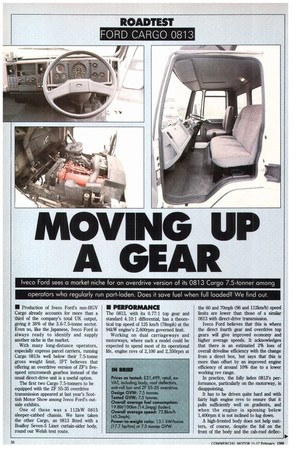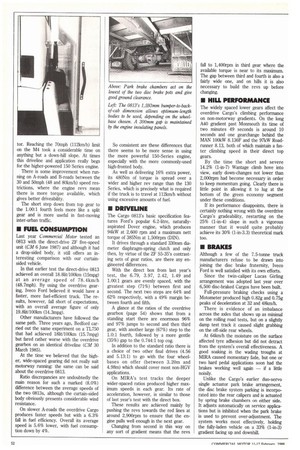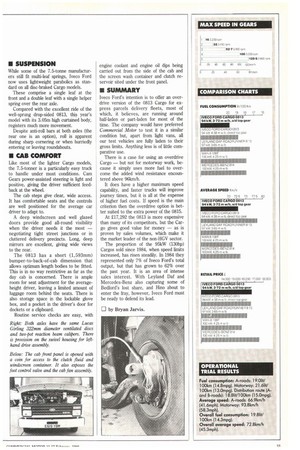MOVING UP A GEAR
Page 60

Page 62

Page 63

If you've noticed an error in this article please click here to report it so we can fix it.
• Production of Iveco Ford's non-HGV Cargo already accounts for more than a third of the company's total UK output, giving it 38% of the 3.6-7.5-tonne sector. Even so, like the Japanese, Iveco Ford is always ready to identify and supply another niche in the market.
With many long-distance operators, especially express parcel carriers, running Cargo 0813s well below their 7.5-tonne gross weight limit, IFT believes that offering an overdrive version of ZF's fivespeed syncromesh gearbox instead of the usual direct-drive unit is a useful option.
The first two Cargo 7.5-tonners to be equipped with the ZF S5-35 overdrive transmission appeared at last year's Scottish Motor Show among Iveco Ford's outside exhibits.
One of these was a 112kW 0815 sleeper-cabbed chassis. We have taken the other Cargo, an 0813 fitted with a Boalloy Seven-5 Liner curtain-sider body, round our Welsh test route. The 0813, with its 0.77:1 top gear and standard 4.10:1 differential, has a theoretical top speed of 125 km/h (78mph) at the 94kW engine's 2,600rpm governed limit.
Working on dual carriageways and motorways, where such a model could be expected to spend most of its operational life, engine revs of 2,100 and 2,350rpm at
the 60 and 70mph (96 and 1I2km/h) speed limits are lower than those of a similar 0813 with direct-drive transmission.
Iveco Ford believes that this is where the direct fourth gear and overdrive top gears will give improved economy and higher average speeds. It acknowledges that there is an estimated 2% loss of overall driveline efficiency with the change from a direct box, but says that this is more than offset by an improved engine efficiency of around 10% due to a lower working rev range.
In practice, the fully laden 0813's performance, particularly on the motorway, is disappointing.
It has to be driven quite hard and with fairly high engine revs to ensure that it pulls sufficiently well on gradients, and when the engine is spinning below 1,400rpm it is not inclined to lug down.
A high-fronted body does not help matters, of course, despite the foil on the front of the body and the cab-roof deflec tor. Reaching the 70mph (112krn/h) limit on the M4 took a considerable time on anything but a down-hill slope. At times this driveline and application really begs for the higher-powered 150 Series engine.
There is some improvement when running on A-roads and B-roads between the 30 and 50mph (48 and 80km/h) speed restrictions, where the engine revs mean there is more torque available, which gives better driveability.
The short step down from top gear to the 1.00:1 fourth feels more like a split gear and is more useful in fast-moving inter-urban traffic.
Last year Commercial Motor tested an 0813 with the direct-drive ZF five-speed unit (CM 6 June 1987) and although it had a drop-sided body, it still offers an interesting comparison with our curtainsided vehicle.
In that earlier test the direct-drive 0813 achieved an overall 18.81ft/1001cm (15mpg) at an average speed of 78.4km/11 (48.7mph). By using the overdrive gearing, Iveco Ford believed it would have a faster, more fuel-efficient truck. The results, however, fall short of expectations, with an overall average figure of only 19.81it/1001cm (14.3mpg).
Other manufacturers have followed the same path. Three years ago, Bedford carried out the same experiment on a TL750 that had achieved 181it/100km (15.7mpg) but fared rather worse with the overdrive gearbox on an identical driveline (CM 30 March 1985).
At the time we believed that the higher, wide-spaced gearing did not really suit motorway running: the same can be said about the overdrive 0813.
Ratio discrepancies are undoubtedly the main reason for such a marked (8.0%) difference between the average speeds of the two 0813s, although the curtain-sided body obviously presents considerable wind resistance.
On slower A-roads the overdrive Cargo produces faster speeds but with a 6.3% fall in fuel efficiency. Overall its average speed is 5.6% lower, with fuel consumption down by 4%. So consistent are these differences that there seems to be more sense in using the more powerful 150-Series engine, especially with the more commonly-used high-fronted body.
As well as delivering 16% extra power, its 480Nm of torque is spread over a wider and higher rev range than the 130 Series, which is precisely what is required if the truck is to travel at 112km/h without using excessive amounts of fuel.
The Cargo 0813's basic specification features Ford's popular 6.2-litre, naturallyaspirated Dover engine, which produces 94kW at 2,600 rpm and a maximum nett torque of 385Nm at 1,500rpm (DIN).
It drives through a standard 330mm diameter diaphragm-spring clutch and only then, by virtue of the ZF S5-35's contrasting sets of gear ratios, are there any engineered differences.
With the direct box from last year's test, the 6.79, 3.97, 2.42, 1.49 and 1.00:1 gears are evenly spaced, with the greatest step (71%) between first and second. The next two steps are 64% and 62% respectively, with a 49% margin between fourth and fifth.
A glance at the ratios of the overdrive gearbox (page 54) shows that from a standing start there are enormous 96% and 97% jumps to second and then third gear, with another large (67%) step to the 1.0:1 fourth, followed by a more gentle (35%) gap to the 0.744:1 top cog.
In addition to the standard ratio there is a choice of two other final drives (4.56 and 5.13:1) to go with the four wheelbases on offer (between 3.20m and 4.98m) which should cover most non-HGV applications.
On MIRA's test tracks the deeper wider-spaced ratios produced higher maximum speeds in each gear. Its rate of acceleration, however, is similar to those of last year's test with the direct box.
These results are achieved mainly by pushing the revs towards the red lines at around 2,900rpm to ensure that the engine pulls well enough in the next gear.
Changing from second in this way on any sort of gradient means that the revs fall to 1,400rpm in third gear where the available torque is near to its maximum. The gap between third and fourth is also a fairly wide one, and on hills it is also necessary to build the revs up before changing.
The widely spaced lower gears affect the overdrive Cargo's climbing performance on non-motorway gradients. On the long A40 gradient past Monmouth its time of two minutes 49 seconds is around 10 seconds and one gearchange behind the MAN 100kW 8.136F and the 97kW Roadrunner 8.13, both of which maintain a faster climbing speed in their direct top gears.
By the time the short and severe 14.2% (1-in-7) Wantage climb hove into view, early down-changes not lower than 2,000rpm had become necessary in order to keep momentum going. Clearly there is little point in allowing it to lug at the bottom of the green economy segment under these conditions.
If its performance disappoints, there is certainly nothing wrong with the overdrive Cargo's gradeability, restarting on the 25% (1-in-4) slope in such a vigorous manner that it would quite probably achieve its 30% (1-in-3.3) theoretical mark too.
Although a few of the 7.5-tonne truck manufacturers refuse to be drawn into joining the disc brake fraternity, Iveco Ford is well satisfied with its own efforts.
Since the twin-caliper Lucas Girling arrangement was adopted last year over 6,500 disc-braked Cargos have been built.
Full-pressure braking checks using a Motometer produced high 0.82g and 0.75g peaks of deceleration at 32 and 48km/h.
There is evidence of an imbalance across the axles that shows up as minimal on the rolling road tests, but on a slightly damp test track it caused slight grabbing on the off-side rear wheels.
At 641an/h the moisture on the surface affected tyre adhesion but did not detract from the system's overall effectiveness. A good soaking in the wading troughs at MIRA caused momentary fade, but one or two hard pedal applications soon had the brakes working well again — if a little noisily.
Unlike the Cargo's earlier duo-servo single actuator park brake arrangement, the disc brake system parking is incorporated into the rear calipers and is actuated by spring brake chambers on either side. It adjusts automatically on service applications but is inhibited when the park brake is used to prevent over-adjustment. The system works most effectively, holding the fully-laden vehicle on a 33% (1-in-3) gradient facing up and downhill. While some of the 7.5-tonne manufacturers still fit multi-leaf springs, Iveco Ford now uses lightweight parabolics as standard on all disc-braked Cargo models.
These comprise a single leaf at the front and a double leaf with a single helper spring over the rear axle.
Compared with the excellent ride of the well-sprung drop-sided 0813, this year's model with its 3.05m high curtained body, registers much more movement.
Despite anti-roll bars at both axles (the rear one is an option), roll is apparent during sharp cornering or when hurriedly entering or leaving roundabouts.
Like most of the lighter Cargo models, the 7.5-tonner is a particularly easy truck to handle under most conditions. Cam Gears power-assisted steering is light and positive, giving the driver sufficient feedback at the wheel.
The cab steps give clear, wide access. It has comfortable seats and the controls are well positioned for the average car driver to adapt to.
A deep windscreen and well glazed doors provide good all-round visibility when the driver needs it the most — negotiating tight street junctions or in cluttered delivery precincts. Long, deep mirrors are excellent, giving wide views to the rear.
The 0813 has a short (1,593mm) bumper-to-back-of-cab dimension that allows optimum length bodies to be fitted. This is in no way restrictive as far as the day cab is concerned. There is ample room for seat adjustment for the averageheight driver, leaving a limited amount of luggage room behind the seats. There is also storage space in the lockable glove box, and a pocket in the driver's door for dockets or a clipboard.
Routine service checks are easy, with Right: Both axles have the same Lucas Girling 322mm diameter ventilated discs and two-pot reaction beam calipers. There is provision on the swivel housing for lefthand drive assembly. engine coolant and engine oil dips being carried out from the side of the cab and the screen wash container and clutch reservoir sited under the front panel.
Iveco Ford's intention is to offer an overdrive version of the 0813 Cargo for express parcels delivery fleets, most of which, it believes, are running around half-laden or part-laden for most of the time. The company would have preferred Commercial Motor to test it in a similar condition but, apart from light vans, all our test vehicles are fully laden to their gross limits. Anything less is of little comparative use.
There is a case for using an overdrive Cargo — but not for motorway work, because it simply uses more fuel to overcome the added wind resistance encountered above 96km/h.
It does have a higher maximum speed capability, and faster trucks will improve journey times, but it is all at the expense of higher fuel costs. If speed is the main criterion then the overdrive option is better suited to the extra power of the 0815.
At £17,292 the 0813 is more expensive than many of its competitors, but the Cargo gives good value for money — as is proven by sales volumes, which make it the market leader of the non-HGV sector.
The proportion of the 95kW (130hp) Cargos sold since 1984, when speed limits increased, has risen steadily. In 1984 they represented only 7% of Iveco Ford's total output, but that has grown to 62% over the past year. It is an area of intense sales interest. With Leyland Daf and Mercedes-Benz also capturing some of Bedford's lost share, and Ilino about to enter the fray, however, Iveco Ford must be ready to defend its lead.




































































































